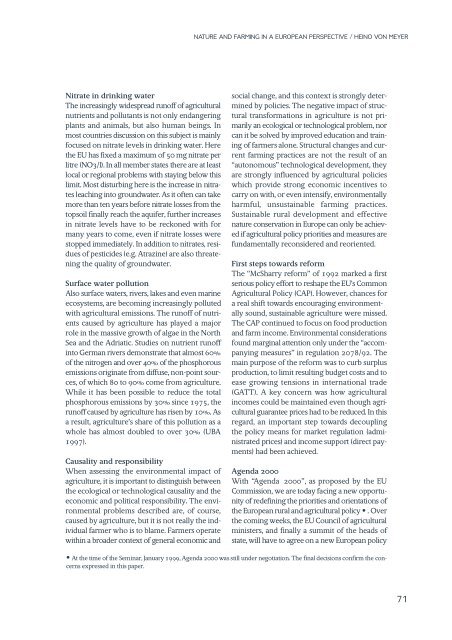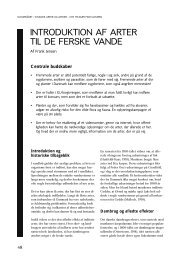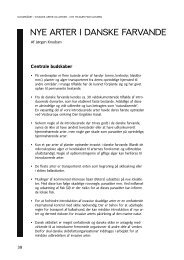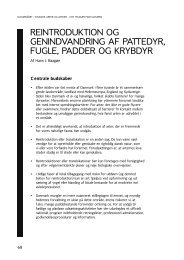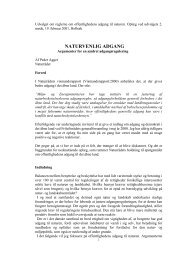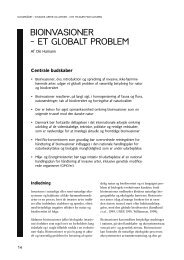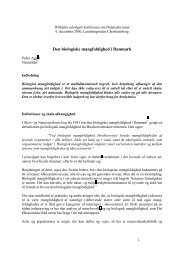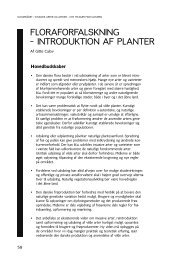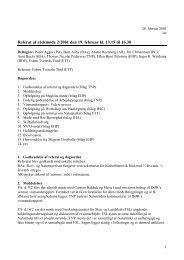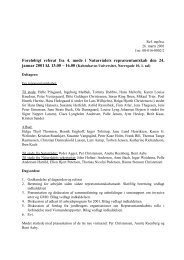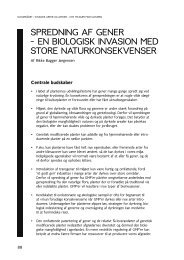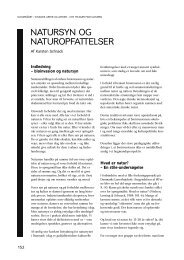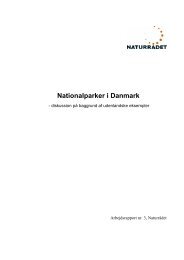Læs hele rapporten som pdf-fil. - Naturrådet
Læs hele rapporten som pdf-fil. - Naturrådet
Læs hele rapporten som pdf-fil. - Naturrådet
Create successful ePaper yourself
Turn your PDF publications into a flip-book with our unique Google optimized e-Paper software.
Nitrate in drinking water<br />
The increasingly widespread runoff of agricultural<br />
nutrients and pollutants is not only endange r i n g<br />
plants and animals, but also human beings. In<br />
most countries discussion on this subject is mainly<br />
focused on nitrate levels in drinking water. Here<br />
the EU has fixed a maximum of 50 mg nitrate per<br />
litre (NO3/l). In all member states there are at least<br />
local or regional problems with staying below this<br />
limit. Most disturbing here is the increase in nitrates<br />
leaching into groundwater. As it often can take<br />
more than ten years before nitrate losses from the<br />
topsoil finally reach the aquifer, further increases<br />
in nitrate levels have to be reckoned with fo r<br />
many years to come, even if nitrate losses were<br />
stopped immediately. In addition to nitrates, residues<br />
of pesticides (e.g. Atrazine) are also threatening<br />
the quality of groundwater.<br />
Surface water pollution<br />
Also surface waters, rivers, lakes and even marine<br />
ecosystems, are becoming increasingly polluted<br />
with agricultural emissions. The runoff of nutrients<br />
caused by agriculture has played a majo r<br />
role in the massive growth of algae in the North<br />
Sea and the Adriatic. Studies on nutrient runoff<br />
into German rivers demonstrate that almost 60%<br />
of the nitrogen and over 40% of the phosphorous<br />
emissions originate from diffuse, non-point sources,<br />
of which 80 to 90% come from agriculture.<br />
While it has been possible to reduce the total<br />
phosphorous emissions by 30% since 1975, the<br />
runoff caused by agriculture has risen by 10%. As<br />
a result, agriculture’s share of this pollution as a<br />
whole has almost doubled to over 30% (UBA<br />
1997).<br />
Causality and responsibility<br />
When assessing the environmental impact of<br />
agriculture, it is important to distinguish betwee n<br />
the ecological or technological causality and the<br />
economic and political responsibility. The environmental<br />
problems described are, of course,<br />
caused by agriculture, but it is not really the individual<br />
farmer who is to blame. Farmers operate<br />
within a broader context of general economic and<br />
NATURE AND FARMING IN A EUROPEAN PERSPECTIVE / HEINO VON MEYER<br />
social change, and this context is strongly determined<br />
by policies. The negative impact of structural<br />
transformations in agriculture is not primarily<br />
an ecological or technological problem, nor<br />
can it be solved by improved education and training<br />
of farmers alone. Structural changes and current<br />
farming practices are not the result of an<br />
“autonomous” technological development, they<br />
are strongly influenced by agricultural policies<br />
which provide strong economic incentives to<br />
carry on with, or even intensify, env i r o n m e n t a l l y<br />
harmful, unsustainable farming practices.<br />
Sustainable rural development and effe c t iv e<br />
nature conservation in Europe can only be achieved<br />
if agricultural policy priorities and measures are<br />
fundamentally reconsidered and reoriented.<br />
First steps towards reform<br />
The “McSharry reform” of 1992 marked a first<br />
serious policy effort to reshape the EU’s Co m m o n<br />
Agricultural Policy (CAP). However, chances for<br />
a real shift towards encouraging environmentally<br />
sound, sustainable agriculture were missed.<br />
The CAP continued to focus on food production<br />
and farm income. Environmental considerations<br />
found marginal attention only under the “accompanying<br />
measures” in regulation 2078/92. The<br />
main purpose of the reform was to curb surplus<br />
production, to limit resulting budget costs and to<br />
ease growing tensions in international trade<br />
( GATT). A key concern was how agricultural<br />
incomes could be maintained even though agricultural<br />
guarantee prices had to be reduced. In this<br />
r e gard, an important step towards decoupling<br />
the policy means for market regulation (administrated<br />
prices) and income support (direct payments)<br />
had been achieved.<br />
Agenda 2000<br />
With “Age n d a 2000”, as proposed by the EU<br />
Commission, we are today facing a new opportun<br />
i ty of redefining the priorities and orientations of<br />
the European rural and agricultural policy • . O v e r<br />
the coming weeks, the EU Council of agricultural<br />
ministers, and finally a summit of the heads of<br />
state, will have to agree on a new European policy<br />
• At the time of the Seminar, January 1999, Agenda 2000 was still under negotiation. The final decisions confirm the concerns<br />
expressed in this paper.<br />
71


